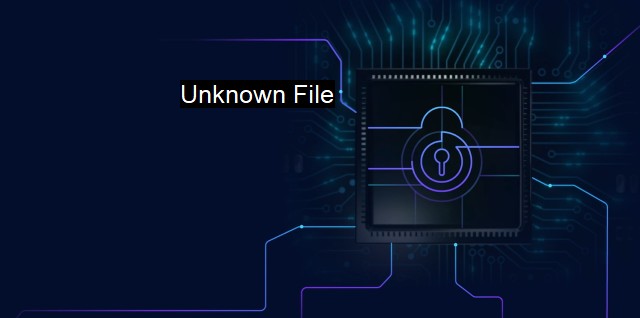What is Unknown File?
Confronting the Challenge of Unknown Files: The Fight Against Obfuscated Malware in Cybersecurity
Unknown files present a significant challenge for antivirus software. An unknown file is a file format or type that antivirus software cannot recognize because it doesn't have a reference point or signature on the database. The purpose of an antivirus software is to detect, isolate and delete malicious files, but when it has no idea about the file type, it becomes difficult.Cybercriminals use unknown files to infect computers with malware. They change the properties of files to allow malware to enter the system undetected. The process of converting a known file type to an unknown one is called obfuscation. Obfuscated files are challenging to detect, and cybersecurity experts must continuously create ways of detecting them.
Unknown files have no detectable signature. File signatures are patterns detected in file types, and they help in detecting malware. when an unknown type of file exists, no signature is present, therefore making it difficult to recognize it as malicious.
Currently, there are several ways that antivirus applications detect malware. One of the methods is the use of signatures. Through signature-based detection, anti-virus software compares the signature of the file in question to the database's more known signatures. If it matches a signature, it deletes the file or isolates it. The disadvantage of using signature-based detection is that it cannot detect new and more advanced types of malware.
On the other hand, heuristic-based analysis looks for patterns and behaviors associated with malware. This approach is highly effective as it is continually updating. When combined with signature-based detection, it is known as dual process detection, which identifies different types of malware easily.
Even with varying systems in use, cybercrime specialists are developing new methodologies daily. This continued evolution of security, commonly known as machine-learning-based detection, uses machine learning in big data to recognize patterns and anomalies that specify profiles of inbound traffic or suspicious files.
Despite these innovative technologies, information security analysts need an expert touch. Recently, machine learning has provided significant steps forward given we have more unknown data categories than before.
Fileless malware takes advantage of remote entry points and holey software that infiltrates through platform-neutral addition. Cyber hackers attack inactive controls and bypasses operating defenses with this utilized technique. Detection is achievable with analytical scrutiny through IaaS solutions (namely Detectify, TribeFixer as well as detect.li) with databases and libraries that cross-match to ascertain if the file requires removing.
Given the systems mentioned (inside Systems: detection strategies), possibilities exist on an institutional level in keeping networks protected by verifying directory files by tracking authentication trail eradication logistics.
Domain compromise access leverages botnets opposed to Trojans as single servers. Damage manifestations are then coordinated in distributed denial of service networks rather than some repelling the masses with social engineering methods. Compatible detection mechanisms SaaS that reveal passive technologies and machine learning scripts exist.
To conclude, unknown files occur when an antivirus software stands down as it lacks matching signatures. Cyber hackers continuously advance their attack tactics through fileless malware campaigns that infiltrate through entry management infrastructure. Revelation possibilities exist with innovative methods preferably performed on an institutional level.

Unknown File FAQs
What should I do if I come across an unknown file on my computer?
It is always best to exercise caution when dealing with unknown files. You should never open or execute an unknown file, especially if it comes from an untrusted source. It could contain malware or viruses that could compromise the security of your computer. It is recommended that you run a virus scan on the file using your antivirus software or upload it to an online virus scanner to determine if it is safe to open or not.What are some signs that an unknown file may contain malware or viruses?
There are a few warning signs that an unknown file may contain malware or viruses. These signs include unexpected pop-up windows, strange error messages, slow computer performance, and unexplained changes to your computer's settings or hardware. If you encounter any of these warning signs, it is best to avoid opening the unknown file altogether.How can I protect my computer from unknown files and malware?
To protect your computer from unknown files and malware, it is essential to have a reliable antivirus software installed on your computer. Ensure that your antivirus software is up-to-date to detect and remove any potential threats. Additionally, exercise caution when downloading files from the internet or opening email attachments. Always verify the source and avoid downloading or opening files from untrusted sources.What should I do if my antivirus software detects an unknown file as a threat?
If your antivirus software detects an unknown file as a threat, it is recommended to quarantine or delete the file immediately. This can be done within the antivirus software. You can also upload the file to an online virus scanner for further analysis. If you suspect that your computer is infected with malware or viruses, you should perform a full system scan with your antivirus software and take appropriate action to remove the threat.| | A | | | B | | | C | | | D | | | E | | | F | | | G | | | H | | | I | | | J | | | K | | | L | | | M | |
| | N | | | O | | | P | | | Q | | | R | | | S | | | T | | | U | | | V | | | W | | | X | | | Y | | | Z | |
| | 1 | | | 2 | | | 3 | | | 4 | | | 7 | | | 8 | | |||||||